Zelkova Trees: Types, Leaves, Bark (Pictures) – Identification
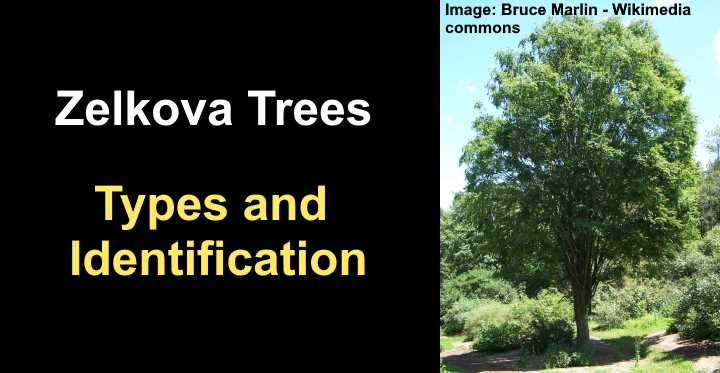
The zelkova tree is a tall ornamental shade tree with a spreading, rounded or vase-shaped crown, attractive gray peeling bark, and large ovate leaves with serrated margins. The broadleaf deciduous zelkova tree produces clusters of non-showy yellowish-green flowers in spring. After blooming, the zelkova tree has small green drupes that mature to brown in the fall.
This article is a complete guide to identifying species of zelkova trees. Descriptions and pictures of zelkova tree leaves, flowers, and bark will help you recognize these attractive trees in the landscape. Additionally, you will get helpful tips on planting a zelkova tree in your yard.
Zelkova Tree Facts
Zelkova is a genus of deciduous trees in the elm family Ulmaceae. There are six species of zelkova trees and various cultivars. The common Zelkova serrata tree is the most common and grows up to 100 ft. (30 m) tall. However, zelkova tree cultivars are typically smaller and grow between 10 and 80 ft. (3 – 24 m).
The popular Zelkova serrata tree is native to Japan, China, Taiwan, and Korea. This is a reason why the leafy ornamental tree has the common name Japanese zelkova. Furthermore, because the zelkova trees are related to elms, the tree also goes by the name Japanese elm.
Apart from being an attractive landscape tree, zelkova trees are also popular bonsai trees. The tree’s growth traits make it ideal for use in bonsai. It is an appealing multi-stemmed tree with a spreading oval crown and beautiful leaves.
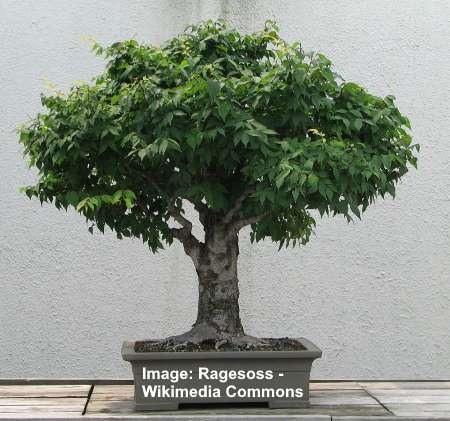
Zelkova serrata bonsai tree
Part of the popularity of zelkova trees is that they are tolerant of a range of conditions. The shade tree with its bushy green foliage tolerates urban conditions, making it ideal as a street tree or ornamental residential tree. In addition, the graceful zelkova tree is tolerant of drought, wind, and heat.
Zelkova trees are cold-hardy in USDA zones 5 to 8.
In addition to being an attractive ornamental tree, the zelkova tree has other uses. For example, in Japan, it has value as a commercial timber tree. In addition, the tree’s timber is used in furniture production and making taiko drums.
The Japanese zelkova tree is also a suitable substitute for growing an elm tree. The zelkovas have similar growth habits to elm trees. However, they are resistant to Dutch elm disease and are much hardier.
Zelkova Tree Leaves
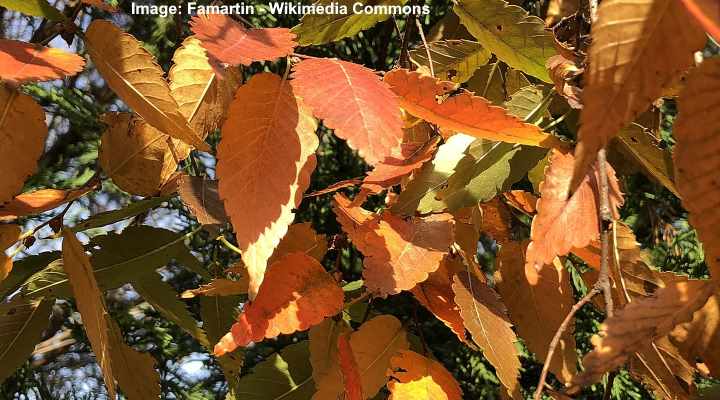
Zelkova leaves in autumn
A zelkova tree has ovate, oblong green leaves with toothed margins. The showy leaves have a smooth texture. Yellowish veins running from the midrib to the serrated edge are clearly visible. Zelkova leaves grow up to 3” (7.5 cm) long and have a tapered point.
The green, ovate zelkova leaves turn spectacular copper, yellow, orange, and red shades before dropping at the end of autumn. This growth characteristic makes zelkova trees especially attractive landscape trees in the fall.
Zelkova Tree Flowers
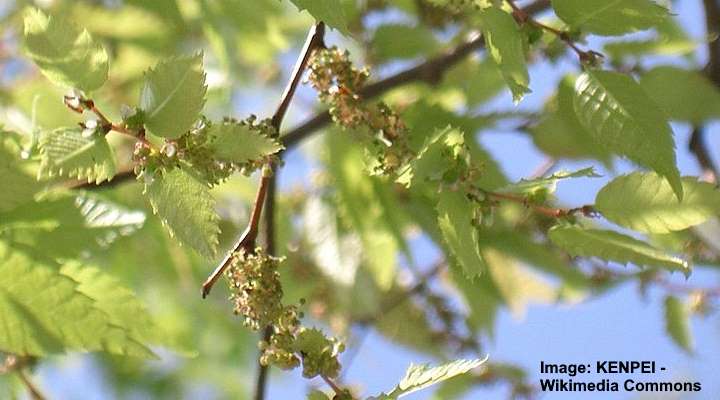
Zelkova serrata flowers
The flowers on a zelkova tree are green-yellow flowers that grow in dangling clusters. Described as “non-showy” or insignificant, the flower clusters appear in spring and persist through summer. Zelkova flowers don’t have petals but consist of stamen clusters that grow on new stems.
Zelkova Tree Fruit
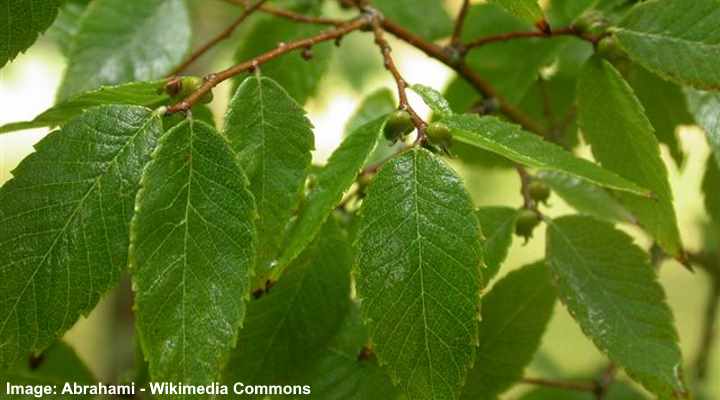
Zelkova leaves and immature fruit
Zelkova tree fruit is a small drupe that appears green in summer after flowering. The small ovoid or triangular fruits develop two tiny white beaks. As the green nut-like fruit matures, it gradually turns brown.
Zelkova Tree Bark
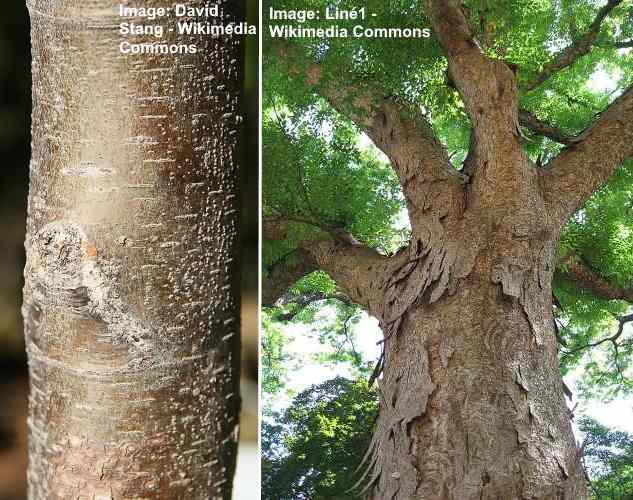
Zelkova bark of young tree (left) and mature tree (right)
Attractive bark is an appealing feature of a zelkova tree. The zelkova tree bark starts reddish-brown and is relatively smooth. An identifying feature of a zelkova tree is the cherry-like bark with pronounced horizontal lines called lenticels. As the tree matures, the bark becomes gray and exfoliating. The peeling bark reveals orange inner bark, adding to the tree’s attractiveness.
Zelkova Tree Identification
Identify a zelkova tree by its short central trunk and spreading branches forming a vase-shaped crown. Zelkovas have grayish-white peeling bark revealing light orange inner bark. Large green serrated ovate leaves turn shades of red, orange, and yellow in the fall. Yellowish flower clusters and nut-like drupes grow on the tree.
Types of Zelkova Trees (with Pictures) – Identification
Let’s look in detail at some common types of zelkova trees.
Zelkova serrata (Japanese Zelkova)
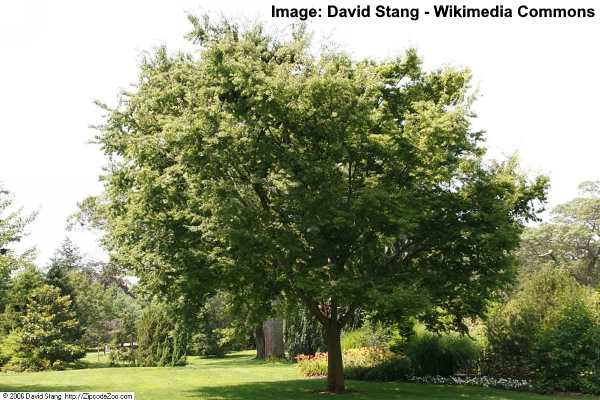
Zelkova serrata tree (Japanese zelkova)
The Zelkova serrata—or Japanese zelkova—is a tall ornamental shade tree with a graceful shape, growing 50 to 80 ft. (15 – 24 m) tall and wide. The deciduous zelkova landscape tree is characterized by large serrated oblong leaves that taper to a point, cherry-like bark maturing to a gray color, and small drupes.
An identifying feature of the Zelkova serrata is its vase-shaped habit. Branches start relatively low on the trunk and spread out, forming a dense canopy with a rounded top. The tree’s growth rate is relatively rapid when young. However, growth slows after a few years, and zelkovas are categorized as slow-growing trees.
Zelkova serrata lance-shaped leaves are one of the attractive features of its growth. The long 3” (7.5 cm) green leaves have toothed edges and with a tapered apex. The medium to dark green leaves grow on the ends of petioles that measure 0.2” (5 mm) long. Each leaf has visible veins that stretch parallelly from the midrib ending in a tooth.
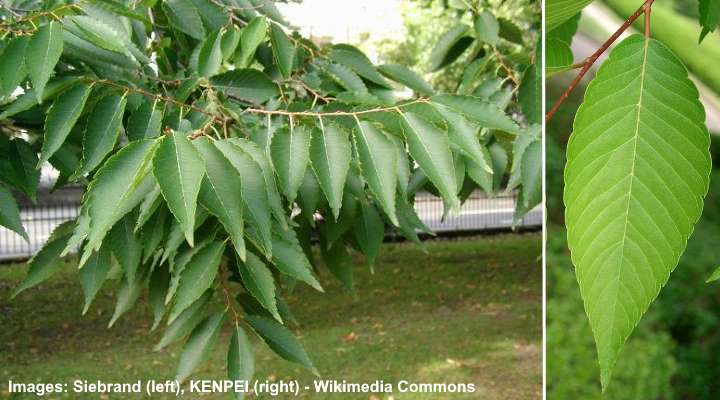
Zelkova serrata leaves
Zelkova serrata bark is known for its attractive gray and orange appearance. Immature Japanese elms have reddish-brown bark that gradually turns gray or grayish-brown as it matures. The bark’s exfoliating nature causes it to peel, revealing patches of orange inner bark. This growth habit gives the zelkova’s bark a cherry tree-like appearance.
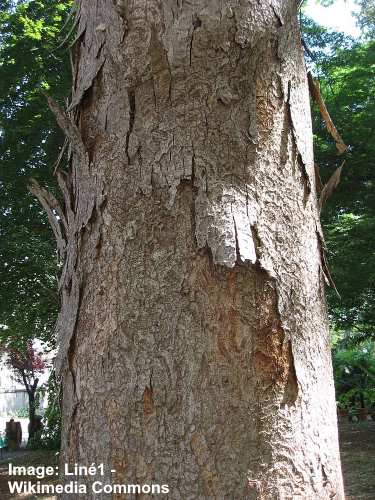
Zelkova serrata bark
As a specimen tree, lawn tree, or garden shade tree, the Zelkova serrata thrives in USDA 5 through 8. The Japanese zelkova performs best in full sun and fertile, moist, well-drained soils. The tree is relatively drought-tolerant when established, especially when planted in heavy soil. Because the Japanese zelkova has good resistance to air-borne pollutants, it also grows well in urban environments.
Although Zelkova serrata is a flowering tree, its blossoms are insignificant. Instead, small clusters of green or yellow flowers appear with new foliage in the spring.
However, the tree’s primary season of interest is in the fall, when its large, toothed leaves make colorful autumn displays. The lanceolate medium-green leaves turn attractive shades of dark red, reddish-purple, golden yellow, and orange.
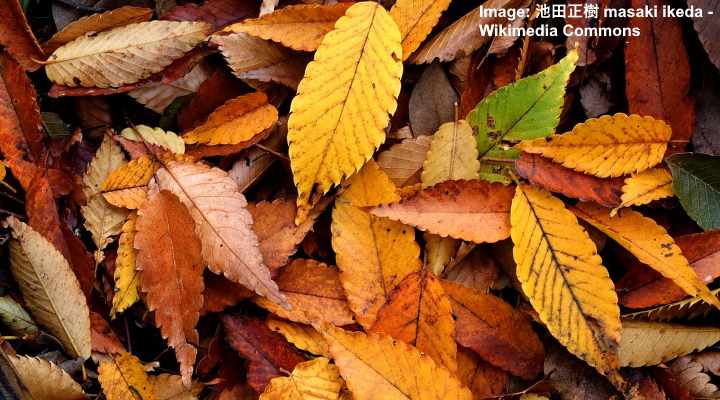
Autumn fallen leaves of Zelkova serrata
Zelkova serrata produces fruit in the form of small nut-like drupes. The small kidney-shaped drupes measure 0.23” (6 mm) in diameter. They appear green in summer after the tree has finished flowering. However, when the zelkova fruits have ripened in the fall, the roundish drupes are brown.
One of the advantages of the Japanese zelkova is its resistance to Dutch elm disease. In many areas, the Zelkova serrata is the ideal substitute for American elm (Ulmus americana) trees. The hardy trees also have excellent resistance to the Japanese beetle and elm leaf beetle.
Some variegated Zelkova serrata cultivars have attractive colorful foliage throughout the growing season. For example, the zelkova ‘Fuiri Keyaki,’ ‘Goshki,’ ‘Pulverulenta,’ and ‘Variegata’ have variegated leaves with green centers and creamy white or yellow margins.
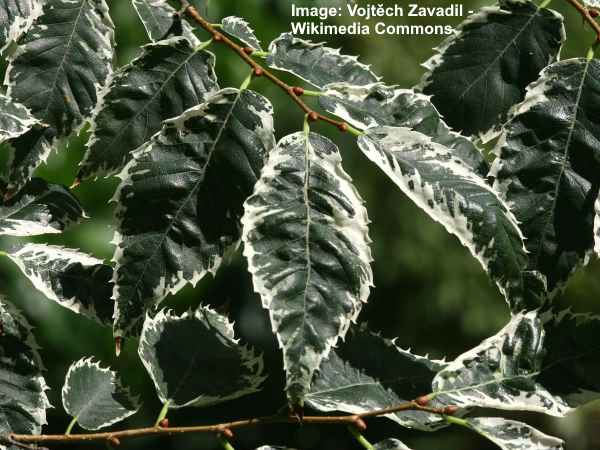
Zelkova serrata ‘Variegata’
Zelkova leaves: Japanese elm tree leaves are lanceolate with serrated margins and acuminate (tapered) tips. Yellowish veins run parallel from the midrib, each ending in one of the pointed tips on the blade margins. The leaves measure 3” (7.5 cm) from the petiole to the apex and are 3” (7.5 cm) at the widest point.
Zelkova identification: To identify a Japanese zelkova tree, look for its short trunk with multiple spreading stems growing in a vase shape with a rounded canopy. The tree has characteristic mid-green lance-shaped leaves that form dense foliage. Zelkova serrata tree has identifiable cherry-like gray bark with pronounced lenticels.
Zelkova serrata ‘Village Green’
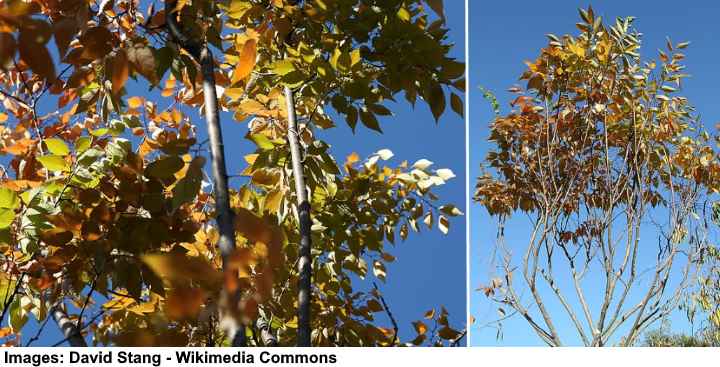
Zelkova serrata ‘Village Green’
The Zelkova serrata ‘Village Green’ is a tall deciduous shade tree with dense foliage and a vase-shaped habit. This zelkova cultivar is identified by its attractive peeling bark that is grayish-brown and exfoliates, revealing light orange patches. The large tree has lanceolate dark green leaves with coarse margins and pointed tips.
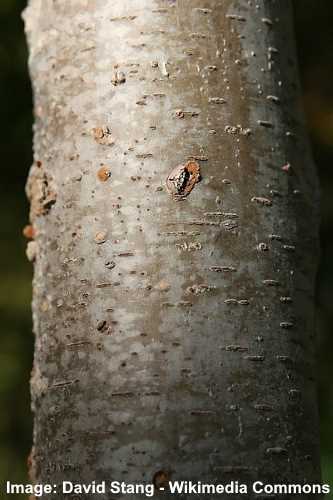
Bark of a young Zelkova serrata ‘Village Green’ tree
The ‘Village Green’ zelkova cultivar is ideal for planting in residential landscapes as an ornamental, shade, or specimen tree. Growing between 50 and 60 ft. (15 – 18 m) with a similar spread, the ‘Village Green’ with its upward-branching crown and graceful shape is ideal for large spaces.
Zelkova serrata ‘Green Vase’
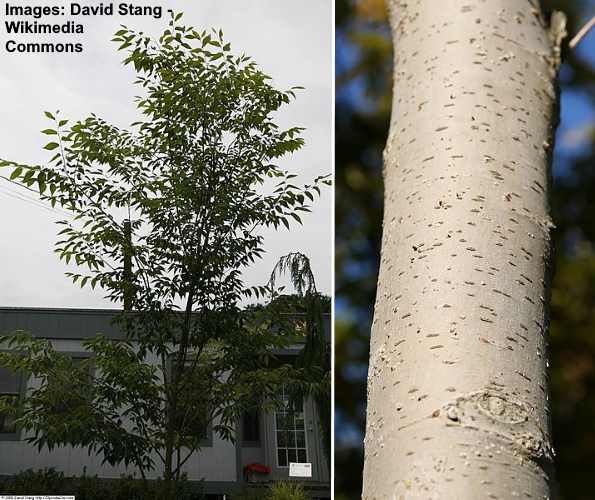
Zelkova serrata ‘Green Vase’ tree and bark
The Zelkova serrata ‘Green Vase’ is a tall, ornamental Japanese elm. The identifying features of the ‘Green Vase’ cultivar are its smooth whitish-gray bark featuring small horizontal bumps (lenticels), a thin trunk, and a narrow, spreading vase-shaped crown. The tree’s dense foliage consists of dark green lanceolate leaves with light green undersides and toothed edges.
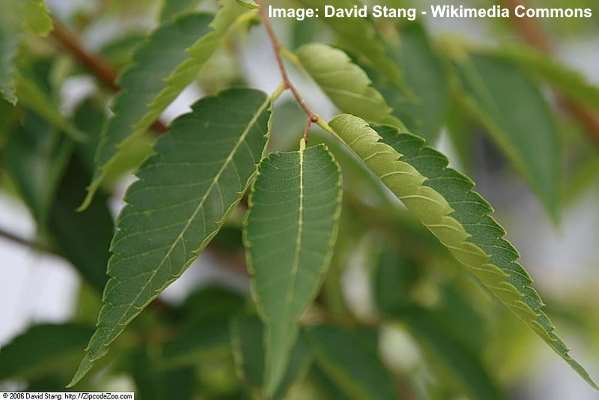
Zelkova serrata ‘Green Vase’ leaves
The ‘Green Vase’ zelkova grows 60 to 80 ft. (18 – 24 m) with a spread of 40 to 50 ft. (12 – 15 m). The showy lance-shaped leaves with their coarse serration turn attractive shades of orange-bronze in the fall.
The differences between the ‘Village Green’ and ‘Green Vase’ cultivars are height and shape. The ‘Green Vase’ zelkova is slightly taller than the ‘Village Green’ with a narrower, upward-spreading crown. Additionally, the ‘Village Green’ has better tolerance for colder climates than the ‘Green Vase.’
Zelkova serrata ‘Musashino’
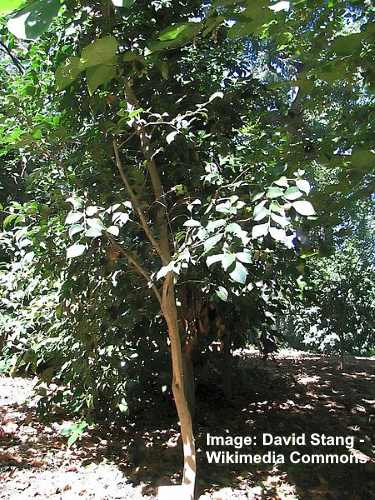
Zelkova serrata ‘Musashino’
The Zelkova serrata ‘Musashino’ is a tall columnar Japanese elm with a narrow vase-shaped habit. The ‘Musashino’ is identified by its small, ovate green leaves with serrated margins, smooth grayish bark covering a straight, slender trunk. ‘Musashino’ zelkova is fast-growing and grows up to 45 ft. (13 m) tall and 15 ft. (4.5 m) wide.
Zelkova abelicea (Cretan Zelkova)
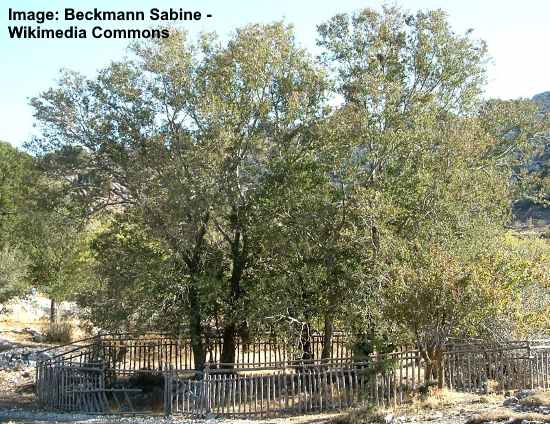
Zelkova abelicea (Cretan zelkova) trees
The Cretan zelkova is a medium-sized ornamental tree growing 33 – 49 ft. (10 – 15 m) tall. The multi-stemmed tree has a shrubby appearance with a dense crown of small green oval leaves with slightly serrated margins. The zelkova also has identifiable flower clusters that produce a pleasant fragrance.
As its common name suggests, the Zelkova abelicea is native to the island of Crete and is endangered in the wild.
In the Greek island of Crete it’s very common to find smaller sized shrub-like zelkova abelica trees with dwarf growth of only 10 – 16 ft. (3- 5 m) tall due to overgrazing by goats and sheep. The tree usually reproduces through suckers that emerge around the main stem.
Zelkova carpinifolia (Caucasian Zelkova)
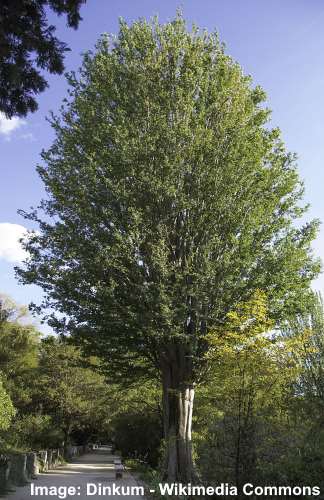
Zelkova carpinifolia (Caucasian Zelkova) tree
The Caucasian zelkova is a mid- to large-sized deciduous tree with a distinctive vase shape, upward-spreading branches, and a short central trunk. The identifying features of the Zelkova carpinifolia are large lance-shaped leaves with toothed edges, small green flowers, and smooth grayish bark. The Caucasian zelkova grows 66 – 115 ft. (20 – 35 m) tall.
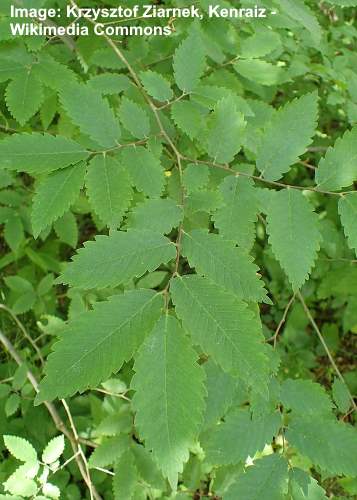
Zelkova carpinifolia leaves
Zelkova carpinifolia leaves are the largest of the Zelkova genus. The pointed ovate leaves measure 1.6” – 4” (4 – 10 cm) long and up to 2.4” (6 cm) wide. Bluntly serrated margins with seven to 12 teeth are also an identifying feature of the leaf.
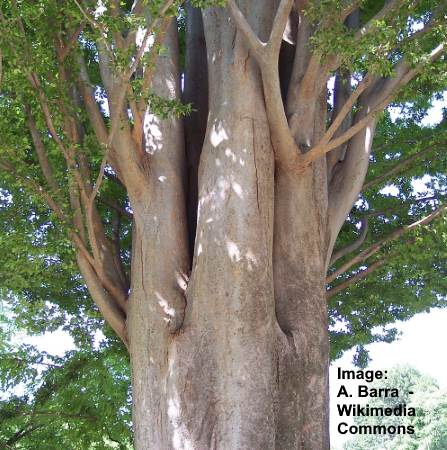
Zelkova carpinifolia bark
How to Plant Zelkova Tree
Zelkova serrata is a popular shade tree in residential gardens. Because the tree has a large spread of up to 80 ft. (24 m), it’s vital to choose a suitable location to plant a zelkova tree. However, there are also Zelkova serrata cultivars available that are beautiful dwarf or small ornamental trees.
To plant a Japanese zelkova tree, find the sunniest spot in your garden with fertile soil and good drainage. Dig a hole the depth of the root ball and twice as wide. To ensure healthy growth, work in a good amount of compost to the soil. However, it’s good to note that zelkova trees tolerate many soil types.
Plant the zelkova tree so that the root collar — the bulge where the roots begin to spread — is just above the surface. Then backfill the hole with the compost-amended soil. Keep pressing down the soil to remove air pockets. After that, water the young zelkova thoroughly.
To care for a zelkova tree, ensure that the ground is kept moist. Although it is drought-tolerant, zelkova trees perform best with infrequent, deep watering during dry summers. This low-maintenance tree doesn’t require any additional fertilization for healthy growth. Adding a layer of bark mulch around the root zone helps lock in moisture and provide some nutrients.
As the zelkova grows, the smooth, reddish-brown bark with cherry-like lenticels becomes grayish-brown, and the peeling bark reveals an orange inner bark.
Related articles:
